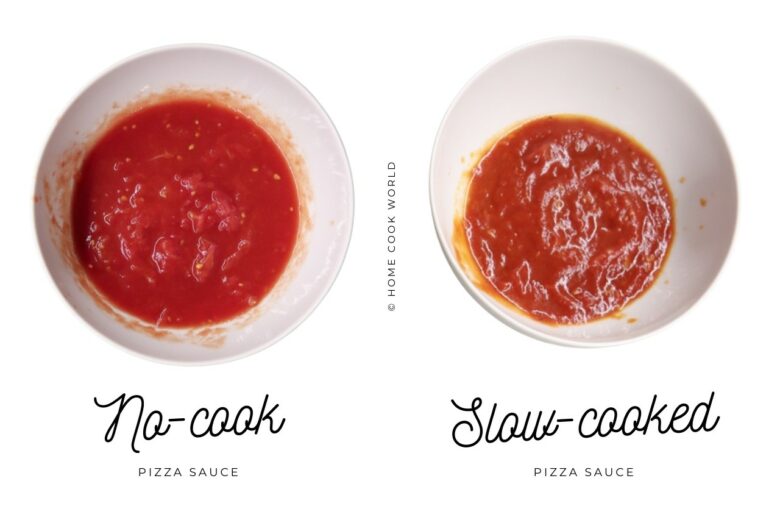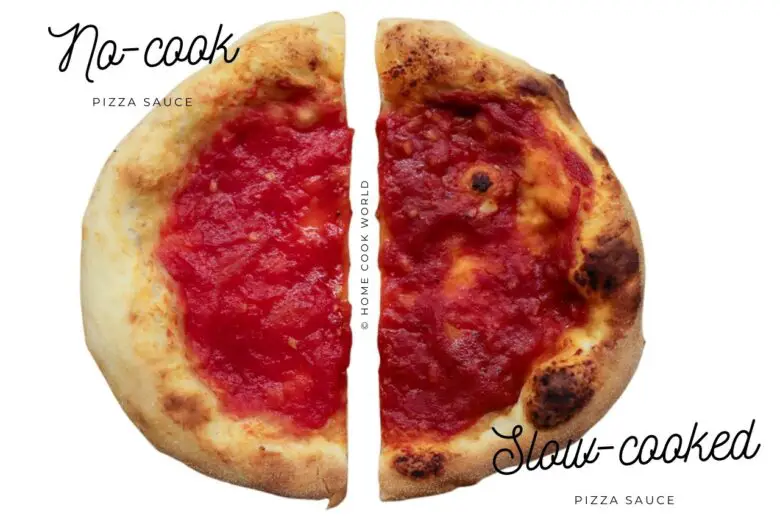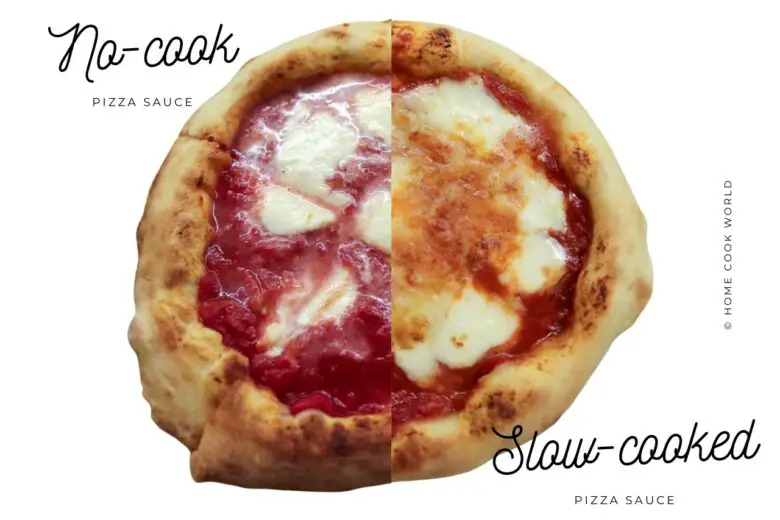As you read pizza recipes on the Internet and in cookbooks, you’ll notice that some of them call for a cooked tomato sauce with a long simmer time, while others tell you to use tomatoes right out of the can.
Should you cook pizza sauce or not?
The choice is entirely yours, and ultimately comes down to your tastes and preferences.
There’s nothing that specifically requires you to cook canned tomatoes. First, they’ve already cooked during sterilization, which makes them safe to eat. Second, they’ll cook a second time around when you bake the pie.
The most obvious difference here is time. It takes no more than a few minutes to open a can and hand-crush the tomatoes before spreading them on a pizza compared to the hour you’ll need to spend watching over the sauce as it simmers down on your stove.
But the more important distinction here is that these two ways of making tomato sauce will also produce entirely different pizzas.
Topping your pizza with tomatoes straight out of the can is generally faster. It leaves the pie slightly soupy and yields a pie that tastes light and fresh. Cooked tomato sauce takes up to 1 hour to simmer down. Topped with it, the pie will come out drier and more savory.
Some bloggers out there will tell you that one way of preparing sauce is better than the other, and you should strictly stick to it whenever you make pizza.
I don’t necessarily agree with them—and here’s why you shouldn’t either.
Personally, I like the zippiness of a pie topped with uncooked sauce. It reminds me of my time in Italy. My wife, on the other hand, prefers hers with cooked sauce. It brings back memories of the ketchup she used to love so much when growing up as a child.
Instead of convincing you to stick to some dogma, I encourage you to make pizza both ways—and see which one you like the most.
Before you do that, here’s everything you need to know about uncooked vs. cooked pizza sauce.
Making No-Cook Pizza Sauce
No-cook pizza sauce is as easy to make as they get. Here’s my recipe:
- Open a can of peeled plum tomatoes and transfer its content to a big enough bowl;
- Crush the tomatoes by hand, leaving them somewhat chunky;
- Add a pinch of fine-grain salt and mix using your fingers.
That’s literally all it takes!
Since you won’t cook the tomatoes, be sure to use a can from a reputable producer and a good variety. My favorites are Cento's Organic San Marzano Tomatoes.
If you feel like splurging, grab a can of Italy-imported San Marzano tomatoes. But any peeled plum tomatoes will do in case you don’t want to break the bank for homemade pizza.
Readers who like their pizza sauce smooth and not chunky can use a blender instead of hand-crushing the tomatoes.
Slow-Cooked Pizza Sauce Recipe
This way of preparing pizza sauce is undoubtedly the slower of the two. It can take up to an hour for the sauce to simmer down on the stove before it’s ready to spread on your pizza.
Cooking tomatoes brings out their acidity and intensity. In other words, slow-cooked pizza sauce will come out thick, dark, and savory.
How to make slow-cooked pizza sauce:
- Open a can of peeled plum tomatoes, transfer its contents into a large bowl, and crush by hand;
- Peel and mince 2-3 garlic cloves;
- Drizzle 2 tablespoons of extra virgin olive oil in a saucepan and bring it up to heat over medium;
- Sauté the garlic for 20-30 seconds until it has released its perfume into the air. Add the hand-crushed tomatoes;
- Season with 1 pinch of salt, 1 teaspoon of balsamic vinegar, 1/2 teaspoon of sugar, and a generous cracking of black pepper. Stir to incorporate;
- Reduce the heat to medium-low and let simmer, stirring occasionally, for 45-60 minutes.
The same piece of advice for the texture of your sauce applies here. If you dislike chunky pizza sauce, use a blender instead of hand-crushing the tomatoes.
Readers who subscribe to the Italian-American traditions of homemade pizza can use Italian seasoning instead of black pepper. Italian seasoning typically consists of black pepper, red pepper flakes, rosemary, oregano, basil, and parsley.
Comparing the Results
Let’s look at the differences between these two sauces before we’ve topped pizza with them.

No-cook pizza sauce has a bright color and light, zippy taste. Though canned tomatoes cook during sterilization, a good can will taste almost as if the fruits of the tomato plant were picked freshly from the garden.
It’s most suitable for traditional Italian pizzas with simple toppings like fresh mozzarella (buffalo’s or cow’s milk), anchovy, and capers.
Slow-cooked pizza sauce has a darker, slightly brown color and a more pronounced flavor. Acidic, sweet, and savory, it tastes almost like grammy’s homemade ketchup.
It pairs well with Italian-American pizzas with more decadent toppings like dried mozzarella and parmesan cheese, sausage, pepperoni, bacon, onions, and mushrooms. Its rich taste is ideal for topping sweeter pizzas like BBQ Chicken pizza and Hawaiian pizza.
The differences between no-cook and slow-cooked sauce were just as noticeable when I used them to make pizza Marinara, the most humble pizza of all topped with just tomato sauce.

The pizza topped with no-cook sauce stayed slightly soupy and tasted fresh, like a Virgin Bloody Mary or pasta pomodoro. Its counterpart topped with slow-cooked sauce tasted cooked, like the tomatoey taste you get in baked ziti or lasagna.
So far, so good. But the chances are that you’ll be adding cheese—and other toppings—to your homemade pizza. So some of you are probably thinking, “How about the differences then?”
To find out, I made Pizza Margherita two ways: with uncooked and with cooked sauce. Here’s what I found out.

Similar to my Pizza Marinara, the no-cook sauce Pizza Margherita had a fresh Virgin Mary-like taste. Because of its lightness and wateriness, this style of sauce pairs particularly well with seafood (shrimp, anchovy fillets, and others) and briny vegetables (capers, olives, artichokes).
The “heaviness” of the cooked tomato sauce made it perfect for meat toppings like bacon, pepperoni, prosciutto, and cheeses with a gamier profile, like Parmigiano-Reggiano, Pecorino Romano, cheddar, and American processed cheese.
In Conclusion
If you like your pizza to taste fresh, top it with hand-crushed peel plum tomatoes straight out of the can. Those who want a more cooked flavor should simmer their sauce down for 45-60 minutes before spreading it on the pie.
Both ways are perfectly legit, and each results in a great pizza in its own unique way. Try them out, and let me and the rest of this post’s readers know which one you liked more (and why) in the comments below.

